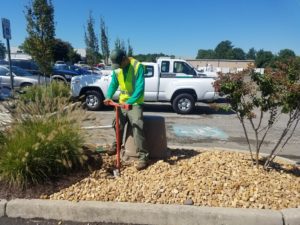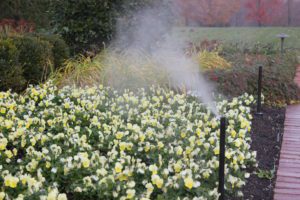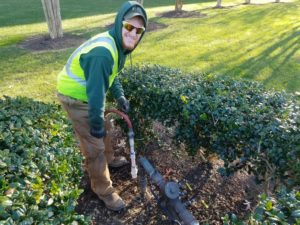By Matt Jones, Irrigation Manager, Richmond Landscape Management Branch
 If you have an irrigation system on your property, then you are probably already familiar with the need for winterization to prevent freeze damage. As temperatures drop in the cold winter months, irrigation components such as backflow preventers, PVC lines, heads and valves are in danger of cracking as water expands and turns into ice. The time to perform winterization is typically November to mid-December, or before extended deep freezing temperatures (i.e. temperatures in the 20’s for more than 6 hours at a time).
If you have an irrigation system on your property, then you are probably already familiar with the need for winterization to prevent freeze damage. As temperatures drop in the cold winter months, irrigation components such as backflow preventers, PVC lines, heads and valves are in danger of cracking as water expands and turns into ice. The time to perform winterization is typically November to mid-December, or before extended deep freezing temperatures (i.e. temperatures in the 20’s for more than 6 hours at a time).
So, what does the winterization process actually look like?
 We shut off the water that feeds the irrigation system from the point of connection (POC). Sometimes this is a dedicated meter, and other times it is a ball or gate valve that separates the irrigation system from domestic water.
We shut off the water that feeds the irrigation system from the point of connection (POC). Sometimes this is a dedicated meter, and other times it is a ball or gate valve that separates the irrigation system from domestic water.- We connect a tow-behind air compressor to the system through a threaded fitting called a blowout. We then use high-volume, low-pressure air (between 45 and 60 PSI) to flush all water out of the PVC lines. This is accomplished by using the irrigation controllers to manually run each zone and let all water escape through the heads. Each zone should be spitting a fine mist out of the heads when that zone is complete.
 Depending on which side of the backflow preventer the blowout cap is located, it may be necessary to remove the backflow preventer from its unions and suck, siphon or drain water out of the incoming side.
Depending on which side of the backflow preventer the blowout cap is located, it may be necessary to remove the backflow preventer from its unions and suck, siphon or drain water out of the incoming side.- To reduce the risk of theft, we will often remove and store brass backflows during the off season. If the backflow remains in place during the winter, it is important to leave all ball valves in the 45-degree position with the blowout cap loose. This allows room for expansion and gives a relief point in the event that someone accidentally re-energizes the system or if the point of connection is passing water.
 All POCs should be tagged and dated to indicate that winterization has been performed and to prevent anyone from accidently re-pressurizing the systems.
All POCs should be tagged and dated to indicate that winterization has been performed and to prevent anyone from accidently re-pressurizing the systems.
The most common mistake that contractors and homeowners make is attempting to use a shop air compressor or tire compressor to winterize their own system. These types of air compressors use high-pressure and low-volume air flow, which can lead to multiple problems. Because the pressure is higher than irrigation systems are designed for, there is an increased risk of a pipe failing and shattering, and the low volume doesn’t provide enough flow for an extended period of time to be able to push out all of the water, which can potentially leave enough water to expand and crack the pipes. To prevent these potential issues, it’s best to have an experienced licensed contractor perform the winterization.
Winterization is typically included in our maintenance contracts as part of an irrigation service package, but it can also be performed as an add-on and billed at the time of service. If you are interested in adding this service or scheduling winterization for your property’s irrigation system, please contact your local Ruppert landscape management branch or call (301) 482-0300 to find the location nearest you.
 We shut off the water that feeds the irrigation system from the point of connection (POC). Sometimes this is a dedicated meter, and other times it is a ball or gate valve that separates the irrigation system from domestic water.
We shut off the water that feeds the irrigation system from the point of connection (POC). Sometimes this is a dedicated meter, and other times it is a ball or gate valve that separates the irrigation system from domestic water. Depending on which side of the backflow preventer the blowout cap is located, it may be necessary to remove the backflow preventer from its unions and suck, siphon or drain water out of the incoming side.
Depending on which side of the backflow preventer the blowout cap is located, it may be necessary to remove the backflow preventer from its unions and suck, siphon or drain water out of the incoming side. All POCs should be tagged and dated to indicate that winterization has been performed and to prevent anyone from accidently re-pressurizing the systems.
All POCs should be tagged and dated to indicate that winterization has been performed and to prevent anyone from accidently re-pressurizing the systems.